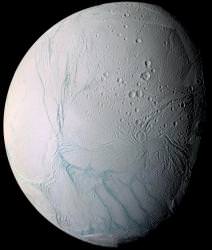 Since Cassini arrived at Saturn, it has made many impressive discoveries. One of the most intriguing is the discovery that Saturn’s icy moon Enceladus has geysers spewing water ice into space. Some planetary scientists theorize that there are pockets of liquid water near the surface of Enceladus that could harbour life. But where is the heat coming from to fuel these geysers?
Since Cassini arrived at Saturn, it has made many impressive discoveries. One of the most intriguing is the discovery that Saturn’s icy moon Enceladus has geysers spewing water ice into space. Some planetary scientists theorize that there are pockets of liquid water near the surface of Enceladus that could harbour life. But where is the heat coming from to fuel these geysers?
A new model proposes that the rapid decay of radioactive elements might be keeping the moon hotter than it would normally be. This heat is released through cracks in the moon’s surface, and since Enceladus is covered with ice, it has water geysers.
The theory says that Enceladus started out as a ball of ice and rock, with rapidly decaying isotopes of aluminum and iron. Over the course of just a few million years, this decay produced a tremendous amount of heat, creating a rocky core and a surrounding shell of ice. The moon then slowly cooled over the course of billions of more years.
This theory matches some of the elements seen in Enceladus’ geysers, such as gaseous nitrogen, methane, carbon dioxide, propane and acetylene. These could come from the decomposition of ammonia deep inside the moon where the warm core and water meet.
Original Source: NASA/JPL News Release
